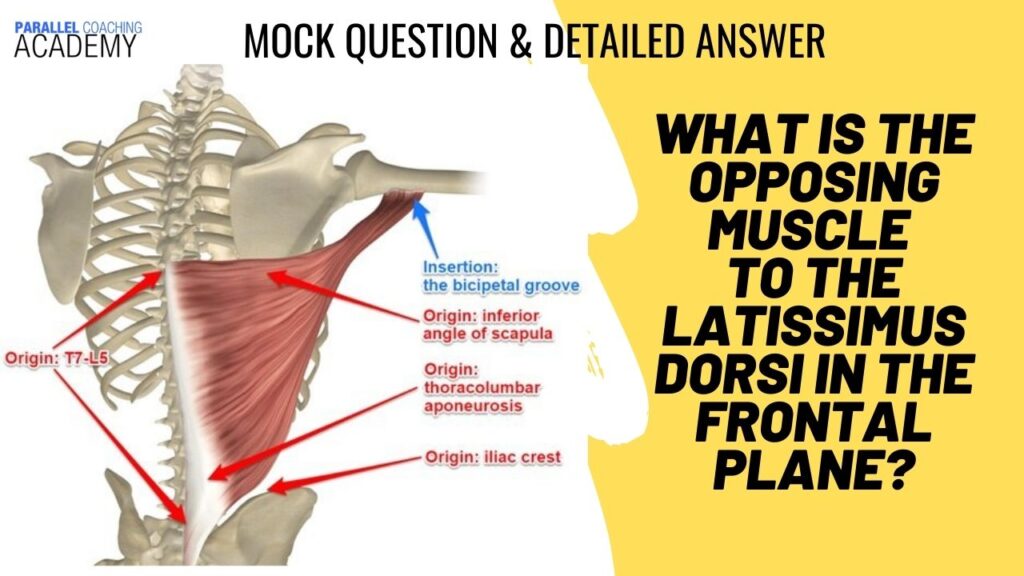A common question in the Level 3 anatomy and physiology exam is “What is the opposing muscle to the Latissimus Dorsi in the frontal plane?” Here we will explore the answer in-depth so you can be confident in your knowledge.
There are 8 topics you must cover in your level 3 anatomy and physiology exam. You can learn about all 8 below. One of these, however, “the body in motion” holds the top spot for being the trickest to get your head around.
In today’s blog, you’re going to learn just one aspect of module 4 – The Body In Motion as we dissect a typical mock question about muscles and planes of movement.
First up press play in the video below and answer the mock question:
One of the keywords in the mock question is “Latissimus Dorsi”
Let’s first learn and revise more about the Latissimus Dorsi muscle.
This is a large muscle found in the back. The Latissimus Dorsi can pull in multiple planes of movement including the frontal and sagittal planes.
In the frontal plane, the Latissimus Dorsi adducts the shoulder e.g. a Lat pull down.
Compared to the sagittal plane the function is to extend the shoulder e.g. a seated row.
The Latissimus Dorsi can only do this due to having multiple origin sites… aka start points of the muscle.
Remember, the origin of any muscle remains still or fixed as the muscle insertion moves or is bought closer to the origin as the muscle contracts.
The origin of the Latissimus Dorsi includes:
- Spinous processes of vertebrae T7-L5,
- thoracolumbar fascia,
- iliac crest,
- inferior 3 or 4 ribs and
- the inferior angle of the scapula
The insertion of the Latissimus Dorsi is the intertubercular groove of the humerus.
Check out the image below and screenshot the muscle memory flashcard.

You can purchase 26 muscle memory flashcards for your level 2 muscle and 50 muscle memory flashcards for your level 3 muscle here:
L2 Muscle Memory Flashcards: HERE
L3 Muscle Memory Flashcards: HERE
The next keyword in the above mock question is “Opposing Muscle“.
Something you learned in your level 2 anatomy and physiology is:
“All muscles work in pairs”.
This would be the prime mover and the opposing muscle to it aka. the antagonist’s muscle.
Ultimately this mock question is asking you to name the opposing muscle, the antagonist muscle to the Latissimus Dorsi.
This is where the Latissimus Dorsi muscle and exam questions become difficult.
We established above the Latissimus Dorsi can move in both frontal and sagittal planes. Therefore the Latissimus Dorsi can have two Opposing Muscles.
One in the sagittal plane and one in the frontal plane.
As we break the mock mock question down further we know the inquiry is within the “Frontal Plane“.
We further established above the Latissimus Dorsi adducts the shoulder in the frontal plane and an example exercise of this is the “Lat Pulldown”.
As you contract the Latissimus Dorsi and pull the bar down towards the clavicle, the shoulder adducts and the elbow flexes.
This is where the Latissimus Dorsi’s frontal plane opposing muscle becomes clear.
By taking the complete opposite or opposing actions we can find the opposing muscle in the frontal plane.
So we looking for an exercise or movement that mimics the reverse of the lat pulldown. Or said differently an exercise that abducts the shoulder and extends the elbow in the frontal plane.
This would be a shoulder press.
We also know from our level 2 anatomy knowledge that the prime mover to the shoulder press is the deltoids.
Therefore, the answer to the above mock question is:
The Deltoids.
As the Latissimus Dorsi and deltoids are agonist and antagonist muscle pairs in the frontal plane.
Likewise, if the level 3 anatomy and physiology exam questions asked:
“What is the opposing muscle to the deltoids in the frontal plane?”
You simply take the deltoids as the prime mover and the Latissimus Dorsi as the antagonist.
Learning and understanding muscles, joint actions, and planes of movement is not only key for passing your level 3 anatomy exam. Equally this knowledge allows you to plan more effective training sessions for your clients.
It also helps you understand key training systems such as Supersets.
Remember anatomy is the study of all the parts that make up the human body and physiology is the study of how all these parts function.
and so fully understand your anatomy and physiology is vital to your success as a FITPRO.
If you want more mock questions like this, then you can download more Free Mock Questions: DOWNLOAD NOW
How to learn orgins and insertions?
Learn, Revise & Remember All 50 Muscles In The Level 3 Anatomy & Physiology Exam.
(and the BEST part…You can do all this in as little as 5-minutes a day)
Each flashcard gives you a clear image and six clear muscle facts:
- Name and Location
- Origin and Insertions
- Muscle Actions
- Joints Crossed
- Primary Planes Of Movement
- Exercise Examples

Dedicated to More
Hayley “opposing muscle to the Latissimus Dorsi” Bergman
Parallel Coaching
P.S. You can also find us on the following platforms:
Instagram: Follow Now
Facebook: Like Our Page
Twitter: Tweet Us
YouTube: Subscribe Here
More Circulatory System Blogs: HERE
More Muscle Revision Blogs: HERE

